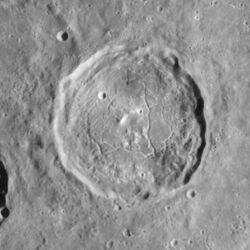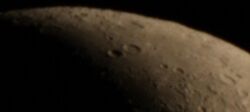Astronomy:Atlas (crater)
 Mosaic of Lunar Orbiter 4 images | |
| Diameter | 87 km |
|---|---|
| Depth | 2.0 km |
| Colongitude | 316° at sunrise |

Atlas is a prominent lunar impact crater that is located in the northeast part of the Moon, to the southeast of Mare Frigoris. Just to the west is the slightly smaller but still prominent crater Hercules. Northeast of Atlas is the large crater Endymion.
The inner wall of Atlas is multiply terraced and the edge slumped, forming a sharp-edged lip. This is a floor-fractured crater with a rough and hilly interior that has a lighter albedo than the surroundings. Floor-fractures are usually created as a result of volcanic modifications.
There are two dark patches along the inner edge of the walls; one along the north edge and another besides the southeast edges. A system of slender clefts named the Rimae Atlas crosses the crater floor, and were created by volcanism. Along the north and northeastern inner sides are a handful of dark-halo craters, most likely due to eruptions. Around the midpoint is a cluster of low central hills arranged in a circular formation.
Atlas is a crater of Upper (Late) Imbrian age.[1]
The name Atlas was formally recognized by the IAU in 1935.[2]
Satellite craters
By convention these features are identified on lunar maps by placing the letter on the side of the crater midpoint that is closest to Atlas.
| Atlas | Latitude | Longitude | Diameter |
|---|---|---|---|
| A | 45.3° N | 49.6° E | 22 km |
| D | 50.4° N | 49.6° E | 25 km |
| E | 48.6° N | 42.5° E | 58 km |
| G | 50.7° N | 46.5° E | 23 km |
| L | 51.3° N | 48.6° E | 6 km |
| P | 49.6° N | 52.7° E | 27 km |
| W | 44.4° N | 44.2° E | 4 km |
| X | 45.1° N | 45.0° E | 5 km |
Exploration
The Atlas crater was the primary landing site of the Hakuto-R Mission 1 by ispace, that launched on December 11, 2022.[3] separating from the rocket 47 minutes later at a distance around 970 kilometres (600 mi) away from Earth.[4][verification needed] If it had been successful, this mission would have been the first private landing on the lunar surface,[5] and would have been the first Japanese probe to land on the Moon.
Communication with Hakuto-R Mission 1 was lost during the final moments of descent to the lunar surface at 16:40 UTC (00:40 JST) on 25 April 2023.[4][verification needed] The iSpace team confirmed that the $90 million dollar spacecraft had most likely crashed during its landing on the Moon. Analysis determined that the lander plummeted uncontrollably when the propellant was exhausted. This happened because the onboard computer wrongly assumed the radar altimeter was faulty, and ignoring its data, misjudged the actual altitude of the spacecraft and kept hovering 5 kilometers above the surface of the Moon.[4][6][7]
References
- ↑ The geologic history of the Moon. USGS Professional Paper 1348. By Don E. Wilhelms, John F. McCauley, and Newell J. Trask. U.S. Government Printing Office, Washington: 1987. Table 11.2.
- ↑ "Atlas (crater)". Gazetteer of Planetary Nomenclature. USGS Astrogeology Research Program.
- ↑ Swift, Rocky (13 April 2023). "Japan's ispace launches commercial moon lander, in potential world first". Reuters. https://www.reuters.com/lifestyle/science/japans-ispace-readies-delayed-launch-first-commercial-moon-lander-2022-12-10/.
- ↑ 4.0 4.1 4.2 "Status Update on ispace Hakuto-R Mission 1 Lunar Lander" (in en). https://ispace-inc.com/news-en/?p=4655.
- ↑ Crane, Leah (28 November 2022). "Japanese firm ispace is racing to put first private lander on the moon" (in en-US). https://www.newscientist.com/article/2348517-japanese-firm-ispace-is-racing-to-put-first-private-lander-on-the-moon/.
- ↑ "Japan Spacecraft Believed to Have Crashed on Moon During Landing" (in en). Bloomberg.com. 2023-04-25. https://www.bloomberg.com/news/articles/2023-04-25/japan-s-ispace-says-it-lost-contact-with-moon-lander.
- ↑ 日本放送協会. "月面着陸 開発の民間企業が会見 “途中で燃料がつきて落下か”". https://www3.nhk.or.jp/news/html/20230426/k10014049671000.html.
- Wood, Chuck (2005-04-03). "Atlas Alone". Lunar Photo of the Day. http://www.lpod.org/?m=20060403.
- "SMART-1 image of crater Atlas". ESA/SPACE X. 2006-02-03. http://sci.esa.int/science-e/www/object/index.cfm?fobjectid=39717.
- Andersson, L. E.; Whitaker, E. A. (1982). NASA Catalogue of Lunar Nomenclature. NASA RP-1097.
- Blue, Jennifer (July 25, 2007). "Gazetteer of Planetary Nomenclature". USGS. http://planetarynames.wr.usgs.gov/.
- Bussey, B.; Spudis, P. (2004). The Clementine Atlas of the Moon. New York: Cambridge University Press. ISBN 978-0-521-81528-4.
- Cocks, Elijah E.; Cocks, Josiah C. (1995). Who's Who on the Moon: A Biographical Dictionary of Lunar Nomenclature. Tudor Publishers. ISBN 978-0-936389-27-1. https://archive.org/details/isbn_9780936389271.
- McDowell, Jonathan (July 15, 2007). "Lunar Nomenclature". Jonathan's Space Report. http://host.planet4589.org/astro/lunar/.
- Menzel, D. H.; Minnaert, M.; Levin, B.; Dollfus, A.; Bell, B. (1971). "Report on Lunar Nomenclature by the Working Group of Commission 17 of the IAU". Space Science Reviews 12 (2): 136–186. doi:10.1007/BF00171763. Bibcode: 1971SSRv...12..136M.
- Moore, Patrick (2001). On the Moon. Sterling Publishing Co.. ISBN 978-0-304-35469-6. https://archive.org/details/patrickmooreonmo00patr.
- Price, Fred W. (1988). The Moon Observer's Handbook. Cambridge University Press. ISBN 978-0-521-33500-3.
- Rükl, Antonín (1990). Atlas of the Moon. Kalmbach Books. ISBN 978-0-913135-17-4.
- Webb, Rev. T. W. (1962). Celestial Objects for Common Telescopes (6th revised ed.). Dover. ISBN 978-0-486-20917-3. https://archive.org/details/celestialobjects00webb.
- Whitaker, Ewen A. (1999). Mapping and Naming the Moon. Cambridge University Press. ISBN 978-0-521-62248-6.
- Wlasuk, Peter T. (2000). Observing the Moon. Springer. ISBN 978-1-85233-193-1.
External links
- Pyroclastic deposits in Atlas crater from USGS Astrogeology Science Center (Clementine 750-nm (albedo) data)
 |




